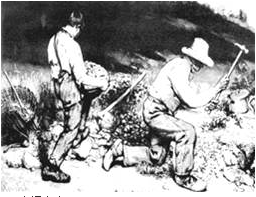阅读下面的内容,完成下面4题
壶口的黄河 肖 铁
在中国看水,看中国的水,最好到黄河。九寨沟的水显得太清秀,俏得有些西方的味道;太湖的水又有点小,文人味太重,不像是水,倒像是供人把玩的装饰物。也许,中国的水应是黄色的,和我们中国人的皮肤一样;而黄河也只有到了这儿,才成了真正的黄河!
车行山谷中,远远便听见阵阵低沉的轰鸣,在左右山壁间碰撞,心也随之律动,未见其影,先闻其声,知道壶口到了。
天渐渐成了黄色,水汽丰富得似乎凭空能捏出一把汗来。
等真正站在她的旁边,所有的人都惊呆了。地竟陷下一层,天也高了一尺,山谷形似壶嘴,水若浊酒,倾泻而下,一仰难尽的气势,充溢胸口,心跳得能蹦出来。耳朵渐渐聋了,只能看见对方开口,却听不见声音;眼也花了,弥漫着的皆是黄色的旋涡,像是从河里蒸腾地上升,又像是奋不顾身地下降。河底升起硝烟一样的股股黄雾,天宇间充涨着黄色带水的颗粒,碰撞在脸上,散发在天上。脑子里一片空白,什么也不敢想,只看着山被水层层劈开,天也被这股黄流斩断。水从天而降,拍打在谷底,响遏在云里。
想黄河从巴颜喀拉山流下的时候,水也该是清的吧?毕竟是雪水的汇集,是上天的洗礼;下游也会清些,因为地势渐平,流速渐缓,黄沙也会慢慢沉在河底。可你看看现在的黄河,刚刚从黄土高原的千沟万壑流过,厚重得带着大地的表皮,圣水也染上了中国的颜色,水里一定还有与大地摩擦而生的余热,当然还有陕北的信天游溶在里面,歌曲带着水旋转。黄河在这里最黄,金黄得如同太阳也落在里面。
黄河之水天上来,如果说往前往后的黄河都是平面的话,到了壶口,黄河一下子像愤怒像高昂像要直抒胸臆地站了起来。这时的黄河是立体的黄河了,像猴子站立起来是人进化的重要标志,黄河站立起来也是一个飞跃,就像个顶天立地的人活了。活了便要说话,那浪涛卷起雷鸣般的吼声,便是她第一声啼哭,第一声就不同凡响。注视着从上而下的水,第一次看到自然里的生命在毫无羁绊的状态下的兴奋和放纵。那啪啪的水击之声便是欢笑,真正的快感,真正的淋漓尽致。看久了,心也会融进那飞溅的黄色水流里。
抬起头,极目四望,北方,阳光打过去,一片白色,水和天连在一起,汪洋恣肆在那里;下游,水会渐渐宽阔,毕竟快到海了,快到生命的终结抑或是升华的地方了,便也心平气和。只有这里,给予黄河的天地竟仅仅小到一个壶口,考验也就在这里了。过去了,黄河便拐了一直角,再往后便没什么能挡住她的了,一泻千里,奔流到海不复还。看看空中的水汽,听听大地的回音,便会知道黄河的自信和决心。跃过去,一跃就五千年,或七十万年,或是一百七十万年,肯定还要久远。司马迁会不会从这里受到了鼓舞,而将那汉代的竹简写尽写穿?易水该是黄河的分支吧,要不荆轲怎么会有壮士一去不复还的气概和性格?
这才是中国的河。西南就是周文王的岐山,就是周武王的丰镐,就是大秦的咸阳,就是盛唐的长安。半坡人该是在这儿舀过水吧?秦嬴政该是从这里出过兵饮过马吧?有这样的水,还有什么可怕的呢?还有什么不可征服的呢?
路德维希为尼罗河作传,也该有人为黄河作传的,那应是中国人的自传!
小题1:作者写黄河,为什么要在开头提到九寨沟和太湖,要在结尾提到路德维希?(4分)
小题2:怎样理解“黄河站立起来也是一个飞跃”中“站立”“飞跃”的含义?(4分 每点2分)
小题3:文章强调“也该有人为黄河作传的,那应是中国人的自传”,这句话有什么含义?(6分)
小题4:从宏观构思的角度看,第二段开始,作者是怎样大处落笔不断变换角度来描写黄河的?又达到了什么样的表达效果?(6分)
小题1:提到九寨沟和太湖,是为了烘托(反衬)黄河的雄浑和博大(2分)。提到路德维希,是因为他曾经为尼罗河作传,由此类比,指出应该为黄河作传(2分)。
小题2:站立:黄河由高处向下倾泻,“像人一样活了”,体现出自由生命的淋漓尽致的活力(或表现出“生命在毫无羁绊的状态下的兴奋和放纵”);
飞跃:经受壶口的考验后,黄河从此便无法阻挡,一往无前(或“从此便没有什么能挡住她的了,一泻千里,奔流到海不复还”)。
小题3:①“该有人为黄河作传”,因为黄河哺育了中华文明,体现了中国的历史与中国人的精神。
②“应是中国人的自传”,是指应该由中国人自己为黄河作传,而不是像非洲的尼罗河那样由欧洲人来作传。
③中国人通过为黄河作传来表现中国人的历史和精神,所以是“中国人的自传”。(每点2分)
小题4:从第二段开始,作者大处落笔,从远闻黄河“声”(1分),到近观黄河“形”(1分),再到追溯黄河“史”(1分),发掘黄河“情”(1分),这就古今交融、形神俱备的展现了黄河的魅力和内蕴的哲理(2分)。
小题1:无
小题2:无
小题3:无
小题4:无

